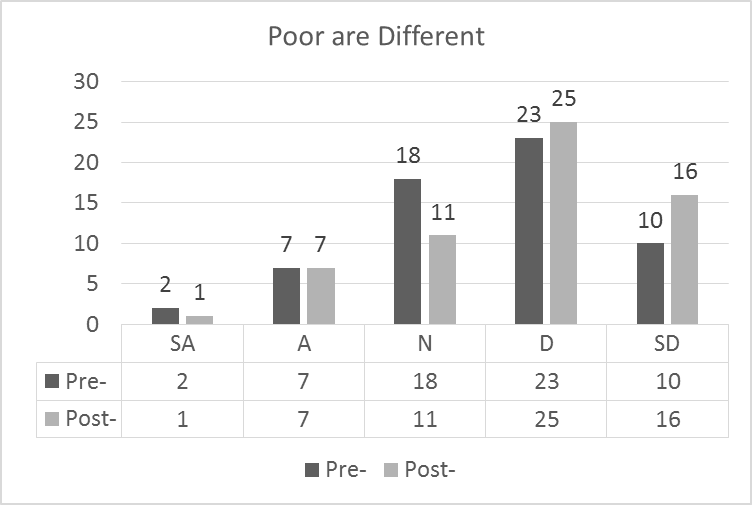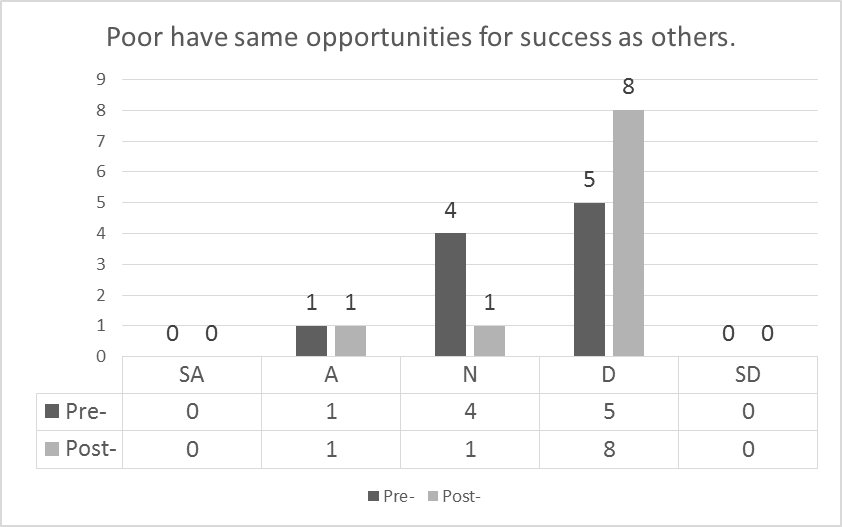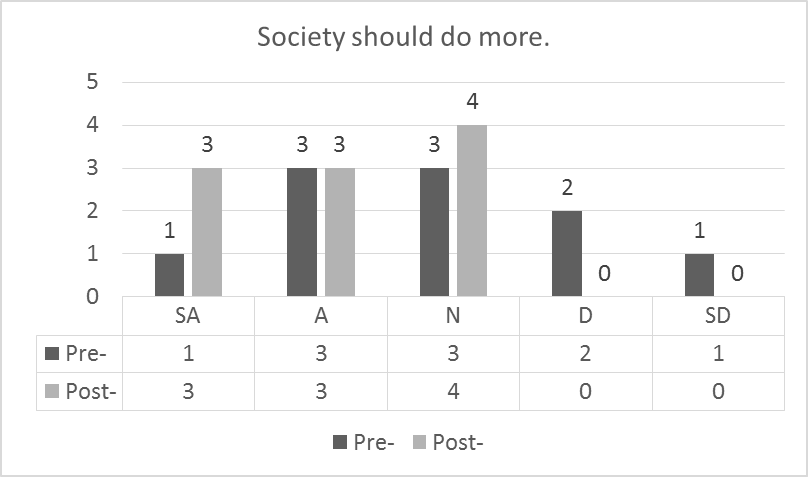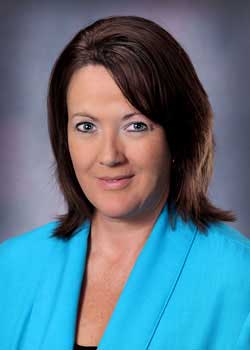Rethinking Service-Learning: Bridging the Gap Between Academic and Student Affairs
Tamara J. Lynn
Fort Hays State University
Author Note
Tamara J. Lynn, Department of Criminal Justice, Fort Hays State University.
Correspondence regarding this article should be addressed to Tamara J. Lynn, Assistant Professor, Department of Criminal Justice, Fort Hays State University, Rarick Hall 233H, 600 Park Street, Hays, KS 67601-4099. Phone: (785) 628-5235. E-mail: tjlynn@fhsu.edu
Abstract
Although the service-learning literature has clearly demonstrated the importance of reflection in connecting service to learning, this is often a difficult task for faculty. As colleges and universities continue to promote civic engagement through a wide array of service activities, in the classroom, and increasingly through co-curricular projects, greater emphasis needs to be placed on reflecting well.
This study evaluated changes in perceptions of poverty by undergraduate students engaged in a co-curricular service project. Poverty was selected as one indicator for understanding concepts of justice. Pre- and post-project surveys were conducted by the student participants, who were members of an on-campus student organization. In addition, guided discussion-based reflection was facilitated by a faculty adviser as well as through interactions with patrons and site supervisors during the project. The findings revealed changes in student attitudes regarding structural issues that promote poverty. As a result, the study concluded that an expanded definition of service-learning which includes co-curricular service cannot be overlooked as an important outlet for student learning and the development of civically engaged citizens.
Keywords: service-learning, co-curricular, reflection, civic engagement
An important goal of colleges and universities is graduating engaged citizens (Smith, Nowacek, & Bernstein, 2010), who appreciate a “heightened sense of responsibility to [their] communities . . . civic sensitivity, participation in building civil society, and benefiting the common good” (Coalition for Civic Engagement and Leadership [CCEL], 2010). Civic engagement produces a civil society in which citizens are aware of issues facing the community, are critical of structures that reinforce inequality, and work together to advocate for social justice (Sievers, 2010). A pedagogical tool for developing civically engaged students is service-learning, which immerses students in community-based activities designed to achieve specific learning objectives measured through structured reflection (Ash & Clayton, 2009).
The practice of service-learning, for the purpose of developing civically engaged citizens, has increased throughout institutions of higher education. Campus Compact, a national coalition that supports member institutions in promoting service-learning, has 30 years of data to demonstrate this increase. Results of a recent Campus Compact survey, for instance, touted a rise in the number of member institutions from 102 in 1986 to 1,100 in 2014. Survey results indicated that 91% of the 434 responding institutions offer service-learning courses. In addition, 64% of these campuses require service-learning in the core curriculum of at least one academic program; 13% require service in order for students graduate; and 29% record service on student transcripts. Additionally, the number of students engaged in service has increased almost 100% from 1986 to 2014 (Campus Compact, 2014).
Nearly all of the institutions that responded to the 2014 Campus Compact member survey indicated that they had implemented a central office responsible for coordinating activities that advance curricular and co-curricular civic engagement. Bartkus, Nemelka, Nemelka, and Gardner (2012) identified key differences between curricular and co-curricular activities. Curricular activities refer to courses of study offered by an institution. Bartkus et al. provided multiple descriptions of co-curricular activities; however, one definition best supports the use of the term in the context of this study: “A co-curricular activity is defined as a club or group that forms, meets, or practices at times other than or in addition to the regular school day and school year” (p. 698). Students enrolled in colleges and universities can participate in a broad range of organizations that encourage and promote involvement outside of the classroom. Students can seek membership in groups that support a major course of study, career goals, cultural practices, and personal beliefs or interests. Though the 2014 Campus Compact member survey accounted for both curricular and co-curricular service, engagement in service does not ensure that learning is taking place.
Frequently cited in the literature, Bringle, Clayton, and Hatcher (2012) defined service-learning as an academic experience in which students engage in service activities that benefit both the student and the community. Specifically, according to their definition, service-learning is:
a course-based, credit-bearing educational experience that allows students to (a) participate in an organized service activity that meets identified community needs, and (b) reflect on the service activity in such a way as to gain further understanding of course content, a broader appreciation of the discipline, and an enhanced sense of civic responsibility. (p. 6)
This definition specifically emphasizes the importance of reflection for enhancing student learning and in developing civically engaged citizens.
Reflection: The Key Component of Service-Learning
Reflection separates service-learning from volunteerism (Eyler, 2002), acting as a “bridge between conceptual understandings and concrete experiences” (Felten, Gilchrist, & Darby, 2006, p. 38). The service-learning literature has increasingly addressed the importance of reflection for strengthening student learning outcomes (Bringle & Clayton, 2012) and in developing civically-minded students (Eyler, 2001, 2002; Nichols, Cazares, & Rodriguez, 2011). Students generally do not engage in reflection “unless intentional efforts are undertaken to make it so” (Eyler, 2002, p. 522). As more colleges and universities promote service activities to develop civically engaged citizens, they need to place greater emphasis on student reflection to ensure that learning is a key component of such activities.
Hatcher and Bringle (1997) described reflection as the “intentional consideration of an experience in light of particular learning outcomes” (p. 153). Reflection promotes civic engagement but only when designed in a manner that enhances the overall experience (Hatcher, Bringle, & Muthiah, 2004). As Felten et al. (2006) argued, “experience alone does not produce learning” (p. 38). Evidence from the literature has suggested that continuous reflection promotes “development of knowledge, skills, and cognitive capacities necessary for students to deal effectively with the complex social issues that challenge citizens” (Eyler, 2002, p. 517). Expanding on these findings, the results of this study suggest that co-curricular service that includes continuous guided reflection, similar to that of academic service-learning, has the capacity to develop civically engaged citizens.
Vogelgesang and Astin (2000) found that academic service-learning has benefits beyond volunteerism for “fostering a sense of civic responsibility and community participation” (p. 29) due to the reflection that guides the learning. Similarly, Keen and Hall (2009) explored the impact of co-curricular service-learning, evaluating whether certain activities promoted attitudes favorable for advancing social justice. They argued that the actual service does not promote these attitudes, but rather the sustained reflection that occurs throughout the experience. Relationships that develop between site supervisors, faculty, and students during a project create opportunities for an ongoing dialogue about social issues that produce inequality and injustice. Because of these partnerships, “students can construct new understandings of what is compassionate and just and what is required of them now and in their future” (Keen & Hall, p. 77). This study’s findings indicate that co-curricular service-learning programs are valuable for developing civically-engaged citizens as long as consistent opportunities for reflection exist.
The literature has clearly established that reflection is essential for service-learning; however, some students struggle with being naturally reflective (Larrivee, 2008). Thus, incorporating meaningful reflection can be perceived as difficult by those for guiding students through this process. Consequently, reflection is often done poorly or bypassed entirely by faculty or staff who have not learned methods for helping students to critically analyze and understand their experiences (Wurdinger & Carlson, 2010). Reflective writing, in the form of journals (Moore, Boyd, & Dooley, 2010) or critical thinking papers (Catlett & Proweller, 2011), is a valuable approach for helping students to think about ideas important to their service-learning experience. If, however, students lack appropriate writing skills, some instructors rely on presentations and discussion-based reflection to facilitate understanding.
However, developing measures to evaluate student learning outcomes connected to writing and presentation assignments can pose further challenges for faculty who lack familiarity with evaluating subjective ideas. Tools for assessing written reflection include the Affect Behavior Cognition (ABC) model (Welch, 1999); the Affect Behavior Cognition 123 (ABC123) model, in which level one represents a self-centered perspective, level two an empathic or “other-ness” perspective, and level three a global or systemic perspective on political and cultural issues (Yates & Youness, 1997); and the Describe Examine Articulate Learning (DEAL) model (Ash & Clayton, 2004; Molee, Henry, Sessa, & McKinney-Prupis, 2010). Discussion-based reflection at the individual and group levels is even more difficult to assess due to the arduous task of quantifying experiences and attitudes. A benefit of co-curricular service-learning is that students can engage in reflection that does not require specific tools for grading.
While co-curricular service-learning does not require grading, reflection is still an important component for promoting understanding and ensuring that service-learning experiences are meaningful. Eyler, Giles, and Schmiede (1996) approached the process of learning via the “4 C’s of Reflection,” which emphasize that reflection should be continuous, connected, challenging, and contextualized. Reflection that is continuous engages students in learning prior to, during, and following a service-learning activity. Reflection that is connective ties experiences of the project to specific cognitive and learning goals. Reflection that challenges students to question their personal assumptions and stereotypes produces critical thinking. Finally, reflection that is contextualized can be guided by faculty or staff in a manner that ensures a greater level of understanding. Approaching reflection in this manner has the potential to turn any service-learning project—academic or co-curricular—into an opportunity for learning.
Purpose and Objective
The purpose of this study was to demonstrate that co-curricular projects that incorporate guided reflection, similar to academic service-learning, are effective for promoting a sense of civic responsibility among college students. The research evaluated undergraduate students’ perceptions of poverty before and after engaging in a service activity that immersed them in an inner-city, poverty-ridden environment. Specifically, the students were members of a campus student organization engaging in the project as a co-curricular activity rather than part of an academic requirement. The faculty advisor incorporated continuous, guided, discussion-based reflection to identify whether student attitudes regarding those living in poverty changed from pre- to post-project.
Methods
This qualitative study captured changes that occurred in student perceptions of poverty as a result of participating in a community-service project.
Participants
Study participants were selected through non-random sampling and included students enrolled at a four-year liberal arts teaching institution located in the midwestern United States. Pre- and post-project surveys were conducted to compare changes in attitudes and beliefs of members of a major-specific, co-curricular, student organization. In addition to the surveys, participants engaged in continuous, guided, discussion-based reflection prior to, during, immediately after, and in the weeks following the project. Qualitative analysis of the reflections was conducted to identify emergent themes.
The co-curricular project was conducted by students who were members of an on-campus student organization. Participation in the organization is voluntary for students who meet the following criteria: (1) the student is majoring or minoring in criminal justice, and (2) he or she maintains at least a 2.5 grade point average (GPA). To attend the project trip, club members were also required to: (1) be of junior or senior status, (2) participate in a minimum of 75% of club activities—including weekly meetings, fundraisers, and service activities—during the fall semester, and (3) participate in the service project as part of the trip. Those who met these requirements and chose to attend were required to pay a nominal fee to offset travel expenses. The remaining expenses were covered by fundraisers facilitated by the club and money provided by the campus student governing organization through annual allocations. Fourteen club members were qualified to attend the trip; however, four did not participate, citing scheduling conflicts or financial limitations. Seven participants used a portion of their spring financial aid disbursement to fund the trip; two participants’ parents paid the fee; and one participant paid with personal income that had been saved specifically for the purpose of attending the trip.
The 10 members who participated in the trip were required to attend additional meetings with the faculty sponsor, above and beyond regular club activities. Discussions that occurred prior to the project emphasized issues of poverty and crime. The faculty advisor took written notes during meetings to document comments made by students. Continuous reflection that occurred throughout the project focused on understanding the physical and social environment of the soup kitchen visited during the project trip and members’ perceptions of those receiving services. Post-project reflection occurred on multiple occasions to promote awareness of the connection between poverty and crime. The faculty advisor recorded key words and phrases used by participants during and immediately following the service activity. Those notes were referenced after the project to create detailed field notes.
Community-Service Project
The project occurred on a spring trip during which members of an undergraduate student organization and the faculty sponsor spent six hours working at a homeless shelter and soup kitchen in a large city in the eastern United States. Information provided beforehand by agency staff indicated that approximately 1,500 people are served lunch at the facility each day of operation and that a majority of the patrons are homeless. Student participants engaged in a broad range of tasks specific to facility operations, including: serving patrons in the food line; carrying trays to tables for those who were disabled; responding to patron requests such as filling drinks; clearing tables; and washing trays. By the end of the project, every member had performed each task.
In addition to completing tasks necessary for serving lunch at the facility, club members interacted directly with site supervisors and patrons. Site supervisors directed the group’s tasks and provided information about the scope of homelessness in the area and about other services offered by the agency. The supervisors engaged in a continual, open dialogue with club members, inquiring about their perceptions of the patrons, the soup kitchen, and the general environment of the facility. The students also interacted directly with those served at the soup kitchen and found that some patrons were very communicative. Topics initiated by patrons varied from politics and other issues of national importance to sharing personal and family stories. Conversely, some patrons would not engage in any discussion, nor would they respond if club members attempted to initiate conversation. Some patrons were combative toward one another, requiring separation by site supervisors. Others were confrontational toward volunteers, including club members.
Survey
Blair, Brown, Schoepflin, and Taylor (2014) developed and validated the Undergraduate Perceptions of Poverty Tracking Survey (UPPTS) to measure undergraduate attitudes toward those living in poverty. Their survey consists of 39 statements that measure seven attitudes varying from perceptions about welfare to understanding poverty. In validating the survey, Blair et al. argued that the results supported previous research (Lane, 2001; Lott, 2002) indicating that many people have strong opinions about those who live in poverty, despite having minimal experience to support their views.
For this study, 11 measures (see Table 1) were selected from the UPPTS that addressed three attitudes: (1) “Those who are poor are different from others”; (2) “Society has a responsibility to do more to help those in poverty”; and (3) “Those in poverty have the same opportunities for success as others.”
Table 1. Survey Attitudes and Statements
|
Attitude |
Statement |
|
PD |
Poor people are different from the rest of society. |
|
Poor people generally have lower intelligence than non-poor people. |
|
|
Most poor people are dirty. |
|
|
Poor people act differently. |
|
|
Being poor is a choice. |
|
|
I believe poor people create their own difficulties. |
|
|
DM |
Individuals should do more to help the poor. |
|
Society has the responsibility to help the poor. |
|
|
EO
|
The poor have the same opportunities for success as everyone else. |
|
If poor people worked harder they could escape poverty. |
|
|
Unemployed poor people could find jobs if they tried harder. |
Note. Attitude labels: PD = Poor are different; DM = Must do more to help those in poverty; EO = Those in poverty have same opportunities.
The survey was measured using a five-point Likert scale with responses ranging from one (Strongly Agree) to five (Strongly Disagree). Club members attending the trip completed the pre-project survey four weeks prior to the scheduled departure. The group completed the post-project survey three weeks after the conclusion of the trip. The latter survey included an open-ended question for students to submit written comments. (See Appendix for the survey questions as well as the open-ended question added to the post-survey.)
Reflection
One of the main challenges of continuous, guided, discussion-based reflection is supporting students in critically analyzing experiences without directly influencing their attitudes. The goal is to guide rather than dictate students’ attitudes and beliefs about a particular issue. In the context of this study, the process of reflection for club members, while continuous, varied from pre- to post-project. As previous research has consistently found (Blair et al., 2014; Lane, 2001; Lott, 2002), people tend to have strong opinions about those in poverty, even though they may have little to no personal experience to support their views. Prior to the project, the faculty advisor encouraged initial discussion among the students to gain a baseline of club members’ beliefs about issues related to poverty. Acquiring this baseline provided the context (Eyler et al., 1996) of student attitudes and was important for guiding the critical-thinking phase in a manner that was supportive and non-judgmental.
Reflection that occurred during and immediately following the project focused on challenging students’ previously identified stereotypes. In addition, inconsistencies between club members’ pre- and post-project perceptions were addressed specifically. Scenarios were used to both support and refute members’ perceptions of the conditions of poverty and those affected by it as the advisor often played “devil’s advocate.” This continual process of guided discussion-based reflection was important for challenging students to understand their own viewpoints and the inconsistencies in thinking that led ultimately to their changed attitudes (Eyler et al., 1996). Furthermore, during reflection, club members began to identify and question others’ inconsistencies, uncovering assumptions and stereotypes, and resulting in higher levels of critical thinking.
Results and Discussion
Two key themes emerged from the results of the pre- and post-project surveys and reflection. Both themes were directly connected to measured participant attitudes. The first theme—“Individual and social barriers prevent success”—relates to issues leading to poverty and barriers that prevent one from achieving success. The second theme—“More must be done, but who is responsible?”—describes a need to support those who live in poverty. The following discussion examines the progression of attitudes about those who live in poverty, specifically in relation to recognizing individual versus social issues that contribute to poverty and crime.
Individual and Social Barriers Prevent Success
Sievers (2010) argued that citizens must be aware of conditions of inequality to produce a civil society. Guided discussion-based reflection that occurred prior to the service project suggested that participants had limited to no knowledge of the structural conditions that influence poverty. This was supported by earlier research conducted by Lane (2001) and Lott (2002), who also found that many people have little knowledge about those who experience extreme poverty. During discussions, participants commented multiple times on why someone who is poor would commit theft and other property crimes. For instance, one club member stated, and others agreed, that “financially motivated crimes provide money to buy food or pay for housing.” Though some supported this claim, several students agreed with another member who countered that “stealing for food is a cop-out. If [the poor] are hungry, they can work at small jobs for cash to buy groceries.” Another club member followed with, “We are poor college students but do not steal to eat.” Statements such as this indicated that members perceived themselves as different from those who are poor because they were “doing something” to improve their situation, while others were simply “being lazy.”
Service-learning projects that expose participants to structural issues of inequality can increase awareness of social issues. Incorporating continuous, guided reflection to make a service-learning experience meaningful (Eyler et al., 1996; Felten et al., 2006) not only increases awareness, but fosters a sense of civic responsibility (Eyler, 2002; Hatcher et al., 2004; Nichols et al., 2011). Figure 1 illustrates the changes in attitudes that occurred from the pre- to post-project survey regarding the attitude that the poor are different. Because the attitude was measured, rather than responses to specific statements, the series of six statements produced a total of 60 responses. Almost no change was noted in the number of respondents reporting that they strongly agree or agree that those who are poor are different, as demonstrated by the pre- to post-project survey results. Greater changes were noted in the numbers of students responding neutral or undecided (18 pre- to 11 post-survey).

Figure 1. Survey results measuring “poor are different” attitude.
This may indicate that club members had limited to no previous exposure to conditions of extreme poverty and therefore did not know what to expect. Both the numbers of those who disagreed (23 pre- to 25 post-survey) and who strongly disagreed (10 pre- to 16 post-survey) that the poor are different increased from the pre-to post-project survey. These results suggested a change in attitude, indicating that at the conclusion of the project club members were not as convinced that the poor are really that much different from themselves.
An important component of this project was the opportunity for club members to engage directly with the patrons being served at the soup kitchen. This interaction provided avenues for continuous reflection connected directly to the concepts of poverty and crime. Initially, the faculty adviser noted that some members seemed very hesitant and much more reserved in their interactions with patrons than in other settings. This observation encouraged the faculty sponsor to guide the reflection based on the context of the experience. Members were asked whether something was wrong. The club member who had previously compared college students to those in poverty expressed “[surprise at] the smells and physical condition” of the patrons. Upon further questioning, this member realized that a homeless person would not have an opportunity to shower daily or buy clothes to replace those that were ragged and torn. Playing “devil’s advocate,” the faculty adviser asked the student why the patrons did not get a job to buy clothes. The club member replied, “Who would hire them if they cannot shower, do not own decent, clean clothes, and smell bad?” This interaction highlights the challenges of reflection when students begin to question their own assumptions.
Three of the survey statements evaluated the attitude that those in poverty have equal opportunities for success compared to others. Changes in attitude from pre- to post-project were noted; however, the greatest measure of change was evident in relation to specific statements rather than the attitude. Figure 2 depicts the 10 responses to the survey statement, “The poor have the same opportunities for success as others.”

Figure 2. Survey results measuring “same opportunities for success” question.
Changes were noted from the pre- to post-survey among participants who were neutral or undecided (four pre- to one post-survey) and those who disagreed (five pre- to eight post-survey). These results indicate that club members did not believe the poor have the same opportunities for success. Responses to the survey, in combination with comments made through reflection, indicated that observing conditions of and interacting with those who live in extreme poverty changes one’s perception of those who live in extreme poverty.
During post-project, guided, discussion-based reflection, the faculty advisor challenged attitudes initially projected during pre-project reflection. Several club members expressed concerns about the physical, social, and individual barriers that would prevent someone from overcoming extreme conditions of poverty. They demonstrated critical thinking by questioning their peers. Specifically, one member, addressing another, asked, “Didn’t you say that poor people commit crime for money because it is easier than getting a job?” The student went on to admonish the group: “How could they possibly have equal opportunities for success when faced with these conditions? Crime may be the only way to survive.” Another member argued that crime may be a natural reaction to “protect themselves out on the streets.” Others expressed concern that many of the patrons appeared to suffer from mental illness, based on how they were “behaving.” A club member added that “without treatment for mental illness, securing employment, housing, and functioning in society would be difficult. If these people cannot function in society, then crime would be a natural response.” Statements like these demonstrated that club members were not only challenging their own assumptions, but achieving a level of critical thinking that supported others in understanding the error of their stereotypes.
More Must Be Done, But Who Is Responsible?
Throughout the pre- and post-project reflection, there was disagreement among club members about the responsibility of others to help those in poverty. Prior to serving lunch at the soup kitchen, about one third of the members strongly disagreed that society had any responsibility for supporting the poor. One explanation given during pre-project reflection was that “no one caused them to be poor, so why should we fix the problem?” Others believed that a plethora of government programs were “already in place to help the less fortunate,” so individuals “do not need to do anything.” Several of these members went on to explain that “because I pay taxes, I am doing my part as an individual to help the government administer these programs.” This pre-project reflection was crucial for understanding the context of club members’ attitudes. As Eyler et al. (1996) argued, reflection must be contextualized to be meaningful.
Two survey statements measured students’ attitudes about whether individuals or society must do more to help those in poverty. Results showed minimal change from the pre- to post-survey; however, when evaluating the statements separately, clear change was noted. Figure 3 highlights attitudinal changes in response to the survey statement, “Individuals should do more to help those in poverty.” The perceived need for individuals to do more to help the poor changed from seven (pre-) to nine (post-) members who strongly agreed or agreed with this claim. More specifically, those who strongly agreed increased from two (pre-) to four (post-). Notably, no club members strongly disagreed that more should be done to help.

Figure 3. Survey results measuring “individuals should do more” question.
Figure 4 illustrates changes in attitude in response to the statement, “Society should do more to help those in poverty.” The number of respondents who strongly agreed or agreed that society should do more to help those in poverty increased from four (pre-) to six (post-), while those who were neutral or undecided changed from three (pre-) to four (post-). As reported in the post-survey, no club members disagreed or strongly disagreed that more should be done to help the poor.

Figure 4. Survey results measuring “society should do more” question.
The results reinforce comments made during reflection indicating that the issue of poverty is “so pervasive that not one person can fix it.” In line with Felten et al.’s (2006) description of reflection as a “bridge between conceptual understandings and concrete experiences” (p. 38), the continuous, discussion-based reflection that occurred prior to, during, and after this project helped students challenge their earlier assumptions regarding those who live in poverty and develop an awareness that extreme poverty cannot simply be “fixed.”
Vogelgesang and Astin (2000), Williams and Perrine (2008), and Bringle et al. (2012) argued that service-learning fosters a sense of civic responsibility due to the reflection that guides the learning. Indeed, the attitude that more should be done to help those in poverty connotes the concept of civic responsibility. A change in attitude was clearly noted through post-project reflection regarding the need to do more to help. Only one club member expressed a certainty that nothing should be done to help; however, ongoing reflection indicated some inconsistency in this opinion as this same member made references to a “cycle of poverty that needs to be stopped.” Two members referenced the importance of understanding the scope of the problem in order to consider a solution, as evidenced by the following statements:
- “This project was valuable for understanding the variety of resources available to those who live in poverty. Those resources are clearly not enough if we do not get to the root of the problem.”
- “I am so glad that I had the opportunity to witness what true poverty looks like. It is impossible to fix a problem if you cannot envision what it is.”
The context of these statements demonstrates that club members were not able to comprehend issues related to extreme poverty without personally experiencing the conditions as well as the people who were subjected to such circumstances. Sievers (2010) maintained that civic engagement produces a civil society when citizens are critical of the structures that reinforce inequality. Results of the guided, discussion-based reflection that occurred after the service project indicated a growing sense of civic responsibility by the students.
As mentioned previously, graduating engaged citizens is an important goal of colleges and universities (Nowacek & Bernstein, 2010). The CCEL argues that civically-engaged citizens experience civic sensitivity, leading to a “heightened sense of responsibility to ones’ communities” in a way that will benefit the common good. When completing the post-project survey, club members were encouraged to provide written comments about the service activity. Two comments alluded to both the responsibility that individuals have for helping the poor and the potential for lifelong engagement:
- “Many people are born into poverty, so escaping is not [as] easy as it seems. Not everyone has the same or equal opportunities for success. Without opportunities, there is limited hope and without hope, crime may seem like a necessary response. This project has opened my eyes to the need for increased opportunities to end the cycle of poverty which may reduce crime. I have my work cut out for me.”
- “Poverty is a serious issue facing society. If we did bring an end to poverty, crime would not cease to exist but I am certain that crime rates would drop. If society cannot bring an end to poverty then we as individuals must find a way.”
Both comments reveal participants’ awareness of the pervasiveness of poverty and of the connection between poverty and crime. Had the group served lunch at the soup kitchen without the continuous and connected reflection that challenged their assumptions about poverty, it is likely that club members would not have experienced the civic sensitivity toward those experiencing extreme poverty. Consequently, they likely would not have developed a sense of personal responsibility for improving their own community.
Conclusion and Implications for Future Research
Reflection is a key component that separates service-learning from volunteerism. Eyler (2002) argued that continuous reflection promotes “development of knowledge, skills, and cognitive capacities necessary for students to deal effectively with the complex social issues that challenge citizens” (p. 517). The continuous, guided, discussion-based reflection that occurred before, during, and after club members served lunch at an inner-city soup kitchen was crucial for promoting awareness of issues related to poverty; understanding structural barriers that prevent people from rising out of poverty; recognizing connections between poverty and crime; and realizing a sense of personal responsibility to help those who experience poverty. The level of introspection and understanding that occurred, as expressed during post-project reflection and indicated by changes from pre- to post-project surveys, suggest that co-curricular projects are useful for developing civically engaged citizens.
The widely accepted definition of service-learning (Bringle et al., 2012) emphasizes “a course-based, credit-bearing educational experience” (p. 6). This project was not course-based, nor was it credit-bearing. The definition continues by stating that the experience provides students the opportunity to participate in, and reflect on, a service activity. Reflection increases understanding of one’s discipline and promotes a “sense of civic responsibility” (p. 6). This project did meet an identified community need. The soup kitchen regularly seeks volunteers to help with the task of serving lunch to approximately 1,500 patrons. In addition, club members engaged in continuous reflection that promoted an understanding of issues related to crime and poverty. Because members of this co-curricular student organization were criminal justice majors or minors, they were able to understand how those in poverty are overrepresented in the criminal justice system. Finally, statements made during reflection clearly indicated “an enhanced sense of civic responsibility.” Co-curricular projects that include intentional, continuous, guided reflection have the potential to provide important learning opportunities, similar to curricular or academic service-learning projects.
The findings of this study clearly demonstrated that changes occurred in undergraduate students’ perceptions of poverty, based on differences between pre- and post-project survey responses; however, that was only a tool to understand how incorporating continuous, guided reflection into a co-curricular service activity can promote learning similar to academic service-learning. This was only one study and not representative of co-curricular service in general. As institutions of higher education continue to expand academic service-learning and co-curricular volunteerism, efforts must be made to ensure evidence of specific learning outcomes. Furthermore, as state governments increasingly tie funding priorities to evidence-based assessment results, a greater emphasis must be made on achieving these standards. Service-learning projects—both curricular and co-curricular—that include intentional and continuous guided reflection are beneficial for promoting student learning and developing civically engaged citizens. Future research that includes intentional, continuous guided reflection as part of a co-curricular service activity is encouraged. As similar results are achieved, a revised definition of service-learning may be warranted.
References
Ash, S. L., & Clayton, P. H. (2004). The articulated learning: An approach to guided reflection and assessment. Innovative Higher Education, 29(2), 137-154.
Ash, S. L., & Clayton, P. H. (2009). Generating, deepening, and documenting learning: The power of critical reflection in applied learning. Journal of Applied Learning in Higher Education, 1, 25-48.
Bartkus, K. R., Nemelka, B., Nemelka, M., & Gardner, P. (2012). Clarifying the meaning of extracurricular activity: A literature review of definitions. American Journal of Business Education, 5(6), 693-704.
Blair, K. D., Bown, M., Scheopflin, T., & Taylor, D. B. (2014). Validation of a tool to assess and track undergraduate attitudes toward those living in poverty. Research on Social Work Practice, 24(4), 448-461.
Bringle, R. G. & Clayton, P. H. (2012). Civic education through service learning: What, how, and why? In L. McIlraith, A. Lyons, & R. Munck (Eds.), Higher education and civic engagement: Comparative perspectives (pp. 101-124). New York, NY: Palgrave Macmillan.
Bringle, R. G., Clayton, P. H., & Hatcher, J. A. (2012). Research on service learning: An introduction. In R. Bringle, P. Clayton, & J. Hatcher (Eds.), Research on service-learning: Conceptual frameworks and assessment (pp. 3-25). Sterling, VA: Stylus Publications.
Campus Compact. (2014). Campus Compact Membership Survey 2014: Three decades of institutionalizing change, 2014. Boston, MA: Campus Compact.
Catlett, B. S., & Proweller, A. (2011). College students’ negotiation of privilege in a community-based violence prevention project. Michigan Journal of Community Service Learning, 18(1), 34-48.
Coalition for Civic Engagement and Leadership (CCEL). (2010). Working definition of civic engagement. Retrieved from http://www.nl.edu/media/nlu/dowloadable/studentservices/
civic-engagement-working-definition-of-civic-engagement.pdf
Eyler, J. (2001). Creating your reflection map. New Directions for Higher Education, 114, 35-43.
Eyler, J. (2002). Reflection: Linking service and learning—linking students and communities. Journal of Social Issues, 58(3), 517-534.
Eyler, J., Giles, D. E., & Schmiede, A. (1996). A practitioner’s guide to reflection in service-learning: Student voices and reflections. Nashville, TN: Vanderbilt University Press.
Felten, P., Gilchrist, L. Z., & Darby, A. (2006). Emotion and learning: Feeling our way toward a new theory of reflection in service-learning. Michigan Journal of Community Service Learning, 12(2), 38-46.
Hatcher, J. A., & Bringle, R. G. (1997). Reflections: Bridging the gap between service and learning. Journal of College Teaching, 45(4), 153-58.
Hatcher, J. A., Bringle, R. G., & Muthiah, R. (2004). Designing effective reflection: What matters to service-learning? Michigan Journal of Community Service Learning, 11(1), 38-46.
Keen, C., & Hall, K. (2009). Engaging with difference matters: Longitudinal student outcomes of co-curricular service-learning programs. The Journal of High Education, 80(1), 59-79.
Lane, R. (2001). Self-reliance and empathy: The enemies of poverty and the poor. Political Psychology, 22, 473-492.
Larrivee, B. (2008). Development of a tool to assess teachers’ level of reflective practice. Reflective Practice Journal, 9(3), 341-360.
Lott, B. (2002). Cognitive and behavioral distancing from the poor. American Psychologist, 57, 100-110.
Molee, L. M., Henry, M. E., Sessa, V. I., & McKinney-Prupis, E. R. (2010). Assessing learning in service-learning courses through critical reflection. Journal of Experiential Education, 33(3), 239-257.
Moore, C., Boyd, B. L., & Dooley, K. E. (2010). The effects of experiential learning with an emphasis on reflective writing on deep-level processing of leadership students. Journal of Leadership Education, 9(1), 36-52.
Sievers, B. R. (2010). Civil society, philanthropy, and the fate of the commons. Lebanon, NH: University Press of New England.
Smith, M. B., Nowacek, R. S., & Bernstein, J. L. (Eds.). (2010). Citizenship across the curriculum. Bloomington, IN: Indiana University Press.
Vogelgesang, L. J., & Astin, A. W. (2000). Comparing the effects of community service and service-learning. Michigan Journal of Community Service Learning, Fall, 25-34.
Welch, M. (1999). The ABCs of reflection: A template for students and instructors to implement written reflection in service learning. NSEE Quarterly, 25(2), 22-25.
Williams, M. A., & Perrine, R. M. (2008). Can leadership development through civic engagement activities improve retention for disadvantaged college students? Opportunity Matters, 1, 33-43.
Wurdinger, S. D., & Carlson, J. A. (2010). Teaching for experiential learning: Five approaches that work. Lanham, MD: Rowman & Littlefield Education.
Yates, M. & Youness, J. (1997). Community service and social responsibility in youth. Chicago, IL: University of Chicago Press.
Appendix
Perceptions of Poverty Pre/Post-Project Survey
Respond to the following statements where 1 = strongly agree; 2 = agree; 3 = neutral/no opinion; 4 = disagree; 5 = strongly disagree.
S.A. A. N. D. S.D.
Poor people act differently than other people. 1 2 3 4 5
Poor people are different from the rest of society. 1 2 3 4 5
Poor people generally have lower intelligence than others. 1 2 3 4 5
Most poor people are dirty. 1 2 3 4 5
Being poor is a choice. 1 2 3 4 5
I believe poor people create their own difficulties. 1 2 3 4 5
Individuals should do more to help the poor. 1 2 3 4 5
Society has a responsibility to help the poor. 1 2 3 4 5
Poor have the same opportunities for success as others. 1 2 3 4 5
If poor people worked harder, they could escape poverty. 1 2 3 4 5
Unemployed poor people could find jobs if they tried harder. 1 2 3 4 5
Feel free to include comments on the back of the survey in response to the following: 1) how have your attitudes changed since participating in this project; 2) what have you taken from this project at a personal level; and 3) has participation in this project changed your goals for the future, and if so, how?
I have read the above survey questions regarding perceptions of poverty and have been given an opportunity to ask questions. By submitting the completed survey, I agree to allow Dr. to analyze the results for research purposes. No identifying information will be provided on the survey. I understand that I am not required to complete the survey and by submitting the completed survey, I understand that I am not giving up any legal rights. I am 18 years or older
Author Biography
 Tamara J. Lynn holds a Ph.D. in Sociology, with an emphasis in Criminology and Politics, from Kansas State University. She has career experience in corrections and alternative education. As the director of an alternative school, she functioned as the school principal of a collaborative program that included public education, special education services, and community mental health. In addition to school operations, she networked closely with social services and the criminal justice system in responding to needs of the students enrolled in the program. She currently teaches fulltime as Assistant Professor in the Department of Criminal Justice at Fort Hays State University. Lynn’s teaching and service have received awards, including a Provost’s Service-Learning Faculty Fellow. As the recipient of research grants, she was instrumental in developing an undergraduate research lab in the department. Her scholarship focuses on service-learning, social control, media framing, and domestic violence.
Tamara J. Lynn holds a Ph.D. in Sociology, with an emphasis in Criminology and Politics, from Kansas State University. She has career experience in corrections and alternative education. As the director of an alternative school, she functioned as the school principal of a collaborative program that included public education, special education services, and community mental health. In addition to school operations, she networked closely with social services and the criminal justice system in responding to needs of the students enrolled in the program. She currently teaches fulltime as Assistant Professor in the Department of Criminal Justice at Fort Hays State University. Lynn’s teaching and service have received awards, including a Provost’s Service-Learning Faculty Fellow. As the recipient of research grants, she was instrumental in developing an undergraduate research lab in the department. Her scholarship focuses on service-learning, social control, media framing, and domestic violence.


